Being into the whole real food thing is tough. You gotta dissect labels for toxic ingredients, trudge off to an actual farm to get food, spend hours slaving away in the kitchen every week, and you don’t have the luxury of picking up an easy frozen meal at a normal grocery store and firing it up in the microwave when you don’t feel like cooking.
Oh but it doesn’t end there. You also have to worry about whether or not the pots and pans that you cook all that healthy food in are killing you. That nonstick skillet you whipped up many a Hamburger Helper with in years past must not be touched. Your trusty old aluminum baking sheets aren’t so trustworthy anymore.
So, then you have to shell out all kinds of cash for more expensive, non-lethal cookware. And don’t even think about donating that Teflon trash to Goodwill. (The gift of cancer isn’t exactly altruistic.)
What’s wrong with nonstick? Or aluminum? Or other normal, not-expensive cookware?
Weell… that’s kind of a long story. But, I kind of get the feeling that most of the health-conscious people who read this blog are already fairly aware of these things. And if you’re not, you are free to Google your way into a nervous breakdown over discovering all the many fatal diseases you’re surely developing as a result of the cookware you’ve been using for the last decade or two. It’s like WebMD out there, you guys. One wrong click and you may as well start planning your own funeral.
Nutshell version? The nonstick coating used in cheap cookware off-gases carcinogenic fumes that build up in your bloodstream and over 90% of people tested have been shown to have significant levels of these toxic chemicals in their blood. And in their baby fetus’ blood. It’s not good. Oh, and aluminum is a toxic heavy metal that causes alzheimer’s, cancer, and other terrible things.
I mean, you’re probably not actually dying as we speak from all that slippery teflon that probably saved you many hours scrubbing off bits of burnt cheese from your pans, but… it is probably best that you start looking around for some alternatives, if that’s what you’re using.
Of course, those alternatives can be pretty spendy. So, here’s my suggestions for picking out what you really need, piece-by-piece, so you can save a little bit of cash, and your sanity, in the process.
Types of Healthy Cookware
First, I want to briefly explain what the basic materials that make for safe cookware are. Your best bets are:
- Stainless steel. Quality matters. Because stainless steel is an alloy of not just carbon steel, but other metals including chromium and nickel, you want the highest-quality stainless steel, which contains less of the cheap heavy metals as filler. Nickel is of primary concern, because it is toxic and can leach from the steel into your food. High-quality stainless steel will have low levels of nickel, and will be constructed in a formulation which makes it resistant to corrosion and leaching or reactivity. To be on the safe side, avoid very long-term cooking and storage of acidic foods in stainless steel, as acids are what can react with the metal causing it to leach.
- Cast iron. This stuff has been used for centuries. When well-seasoned, cast iron cookware has a coating of polymerized fat which not only turns it into a nice non-stick surface, but acts as a barrier between the iron and your food. More on this in a bit when we get to choosing cast iron cookware.
- Enamel coated cast iron or steel. Naturally non-stick and non-porous. Again, quality matters. High-quality enamel coating is non-reactive and safe for all types of cooking. Lesser-quality enamel may contain lead, or may chip, allowing unsafe material underneath the coating to leach into food.
Now, let’s pick out some pots and pans! Here’s what you need.
A Couple Saucepans or Pots
You gotta have at least a basic saucepan and/or pot. Stainless steel is an old standby outside of the realm of non-stick, and I agree that it’s a good choice. All Clad is generally considered to be the cream of the crop when it comes to stainless steel, and for good reason. They’ve earned their solid reputation over the years with high-quality products that stand the test of time, and are well-constructed with heat-conducting aluminum sandwiched between layers of quality magnetic steel.
Here’s All Clad’s 3 quart saucepan with lid. I think 3-quart is a good size that can be used for a variety of different jobs. I like that it’s more squatty rather than deep. If I had to pick just one basic pot, this would be it.
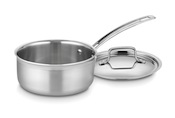 Cuisinart’s “MultiClad Pro” line is a cheaper alternative to All Clad. Clearly, they’re trying to compete with All Clad directly, with both the name as well as the 3-ply construction. I’ve heard that it’s comparable, and passes the magnet test. This is their 2-quart saucepan, but they have it in several sizes.
Cuisinart’s “MultiClad Pro” line is a cheaper alternative to All Clad. Clearly, they’re trying to compete with All Clad directly, with both the name as well as the 3-ply construction. I’ve heard that it’s comparable, and passes the magnet test. This is their 2-quart saucepan, but they have it in several sizes.
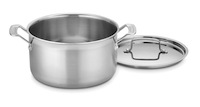 If you think you’d have use for a small-ish stock pot/saucepot (we’ll get to the more necessary big stock pots in a bit), this 6-quart Cuisinart would be my vote. All Clad also makes a 6-quart pot, but for the price, I’d skip it and use an enamel dutch oven instead. However, for things like browning a roast before throwing it in the oven, or boiling a decent-sized pot of spaghetti or something, this is a good piece to have.
If you think you’d have use for a small-ish stock pot/saucepot (we’ll get to the more necessary big stock pots in a bit), this 6-quart Cuisinart would be my vote. All Clad also makes a 6-quart pot, but for the price, I’d skip it and use an enamel dutch oven instead. However, for things like browning a roast before throwing it in the oven, or boiling a decent-sized pot of spaghetti or something, this is a good piece to have.
At least one non-reactive pot and/or saucepan
This is really not entirely necessary, since quality stainless steel is only reactive with very acidic things cooked at high temperatures, and I would only even worry about that if it were cooked for a long time, like hours. Especially if you plan on getting an enamel-coated dutch oven, you can definitely live with just one or two stainless pots/pans. But, the non-reactive pans do come in handy for certain things, and for my ideal list of essential cookware, this makes the list.
For me, I just need a little baby pot for cooking up smaller things, or heating up leftovers. And this adorable 1 1/4 quart Le Creuset saucepan definitely fits the bill. If I’m actually going to be cooking a batch of tomato sauce or chili or something else really acidic, I’m probably going to make a big batch of it, and for that I’d use an enamel-coated dutch oven or stock pot.
Enamel Dutch Oven
The name “Dutch Oven” is a little misleading (at least, it was to me), since they aren’t only for baking purposes or other oven-only kitchen endeavors. A dutch oven can most certainly be used entirely on the stovetop. So, if you were to cook something that would be too acidic for a stainless stock pot or saucepan, you can use one of these. The cream of the crop version of enamel dutch ovens is Le Creuset. French-made of the highest quality materials, Le Creuset products are made to last for generations. And their bright, delicious colors are beyond swoon-worthy. Oh, and they of course refer to their dutch ovens as “French ovens”—haha!
Ooh, la la. This 5 1/2 quart round Le Cresuet French oven is a classic beauty, and an heirloom piece that’s sure to be appreciated for a long, long time in your kitchen. Perfect for soups, stews, roasts, casseroles and almost anything else you can think of—the cast iron retains heat more efficiently than just about any other cookware material. And the enamel coating keeps it non-reactive and non-stick. Comes in all sorts of lovely colors, and other sizes are available, too.
A more budget-friendly version is this nice little 6-quart dutch oven from Lodge. Also constructed of cast iron with a porcelain enamel coating, it’s a solid choice. These do come in several different color options too, like this “Island Spice Red,” but, I don’t think they quite compare to the gorgeousness that is Le Creuset. Still, this is a great choice if the LC is out of budget.
A Nice, Big Stock Pot
Because every kitchen needs a big ol’ stock pot. For cooking big ol’ batches of good, home-cooked food.
All Clad is a great bet for this item, too. This 12-quart “multi-cooker” is a stock pot and steamer in one. The basket would sure come in handy for things like draining pasta, too. I think it’s a pretty good deal for what you’re getting, considering All Clad’s pricing.
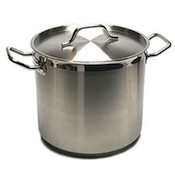 This 20-quart stainless steel pot is a not-so-little gem I found while searching for All Clad stock pots on Amazon. My understanding is that this no-name brand, “New Professional” is geared toward literal professionals—as in, to be used in a real, commercial restaurant kitchen. Their high-quality stainless steel commercial-grade pots have been certified by the National Sanitation Foundation, and New Professional had this to say about the independent testing company: “Many professional restaurants adhere to using NSF listed cookware in their commercial kitchens. The NSF logo can be found on millions of consumer, commercial, and industrial products today. Products evaluated and certified by NSF International include bottled water, food equipment, home water treatment products, home appliances, plumbing and faucets, and even pool and spa components. No other independent testing programs require companies to comply with the strict standards imposed by NSF and its product certification programs.” Sounds pretty legit, to me. New Professional offers stock pots in sizes from 8-quart all the way up to a massive 40-quart.
This 20-quart stainless steel pot is a not-so-little gem I found while searching for All Clad stock pots on Amazon. My understanding is that this no-name brand, “New Professional” is geared toward literal professionals—as in, to be used in a real, commercial restaurant kitchen. Their high-quality stainless steel commercial-grade pots have been certified by the National Sanitation Foundation, and New Professional had this to say about the independent testing company: “Many professional restaurants adhere to using NSF listed cookware in their commercial kitchens. The NSF logo can be found on millions of consumer, commercial, and industrial products today. Products evaluated and certified by NSF International include bottled water, food equipment, home water treatment products, home appliances, plumbing and faucets, and even pool and spa components. No other independent testing programs require companies to comply with the strict standards imposed by NSF and its product certification programs.” Sounds pretty legit, to me. New Professional offers stock pots in sizes from 8-quart all the way up to a massive 40-quart.
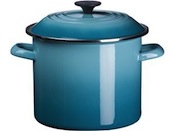 Stainless steel is a great choice for most types of cooking, but if you’re going to be cooking a giant batch of something with a tomato base, like chili or tomato sauce, simmered on the stove for hours on end? I’d probably suggest going with an enamel-coated stock pot if it’s a big enough batch to not fit in a dutch oven. This 8-quart enamel-on-steel Le Creuset stock pot comes in those all those pretty colors, and is what I would choose.
Stainless steel is a great choice for most types of cooking, but if you’re going to be cooking a giant batch of something with a tomato base, like chili or tomato sauce, simmered on the stove for hours on end? I’d probably suggest going with an enamel-coated stock pot if it’s a big enough batch to not fit in a dutch oven. This 8-quart enamel-on-steel Le Creuset stock pot comes in those all those pretty colors, and is what I would choose.
What about making actual stock (bone broth)?
I actually do not use my stock pot for making stock or bone broth. Like, ever. I used to use a crock pot, which was an easy way to leave broth simmering for 24+ hours and not having to worry about the house burning down, but recently I have discovered the most amazing alternative and I probably will never use a crockpot to make stock again. Behold:
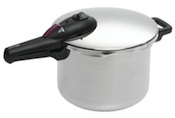 The pressure cooker. I recently got a stainless steel pressure cooker (mine was the 8-quart size which is not currently available on Amazon), and the very first thing I did with it was make bone broth. A heaping pile of bones, some veggie scraps, a glug of vinegar and a gallon of water went into that thing, I heated it up for a few minutes to bring it to pressure, and then cooked on low for just a half-hour, and BAM! Amazing, flavorful broth that GELLED perfectly without even using particularly gelatin-rich things! I usually have to add at least a few chicken feet to even HOPE for a solidly-gelled broth from the crock pot. This will be my only method for stock/broth making from now on. I’m totally hooked.
The pressure cooker. I recently got a stainless steel pressure cooker (mine was the 8-quart size which is not currently available on Amazon), and the very first thing I did with it was make bone broth. A heaping pile of bones, some veggie scraps, a glug of vinegar and a gallon of water went into that thing, I heated it up for a few minutes to bring it to pressure, and then cooked on low for just a half-hour, and BAM! Amazing, flavorful broth that GELLED perfectly without even using particularly gelatin-rich things! I usually have to add at least a few chicken feet to even HOPE for a solidly-gelled broth from the crock pot. This will be my only method for stock/broth making from now on. I’m totally hooked.
Skillets of All Sizes
Now this is where you can really save some money! For most of my skillet usage, a small cast iron pan fits the bill.
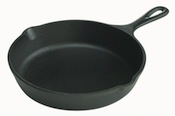 Lodge cast iron skillets come in sizes all the way from a wittew baby 3.5″ one (that I own and am obsessed with) to this big, honking 17-inch beast. The size from my collection that gets used the most, however, is this 8-incher. It is perfect for omelettes and frying up all sorts of things for just Mr. B and I.
Lodge cast iron skillets come in sizes all the way from a wittew baby 3.5″ one (that I own and am obsessed with) to this big, honking 17-inch beast. The size from my collection that gets used the most, however, is this 8-incher. It is perfect for omelettes and frying up all sorts of things for just Mr. B and I.
What about iron leaching?
There are some concerns out there about cast iron leaching actual iron into your food. Some say that this is a good thing—since many people are anemic, or iron-deficient. But there’s also the argument that you could be ingesting too much iron, since excess levels of iron in the blood can be problematic.
I don’t think this is an issue we really need to worry much about, but there are a few things you’ll want to keep in mind when using cast iron, because it is possible for cast iron to leach iron into your food.
You can reduce this significantly by simply keeping your cast iron well-seasoned. The seasoning is basically a layer of crystalized (polymerized is the technical term) fat, which sits on top of the actual iron itself (and in between it and your food). Also, it’s best to avoid cooking things which are very wet—like sauces—in cast iron, as well as things which are highly acidic—like tomatoes. This not only draws iron out of the pan and into your food, but can break down your seasoning. And you really don’t want that to happen.
Cast iron pans are best for things that you’d use a spatula for—not a spoon. It’s for this reason that I don’t have a bare (as opposed to enamel-coated) cast iron dutch oven, or other pot that you’d cook soupy things in. I only have cast iron skillets, and I use them mostly for short-term cooking of not-very-wet things, like sauteing veggies, or making omelettes, or even fun things like baking cornbread, since cast iron skillets can go in an oven, too.
If it’s saucy, wet, or acidic, use a different piece of cookware. Enamel-coated cast iron pans are ideal.
A Good Enamel Skillet
Enamel-coated cast iron skillets have all the benefits of cast iron, without the possibility of the metal reacting to foods and leaching. And, they are low-maintenance, as they’re naturally non-stick without any seasoning to maintain.
Le Creuset is the winner again here, but since they are kinda spendy, choose wisely. I went with this 10 1/4 inch size, but if you think you could really use a bigger one, get that. I mean, it would be ideal to have both, but if you think you’d need a bigger one at times, get that first. The next size up is 11 3/4 inch, and it’s about $35 more than the smaller one.
Both Lodge and Cuisinart also make an enamel-coated skillet that is more economical (but not as fun and fancy, and judging by the reviews, definitely not as high-quality as Le Creuset).
A Big Frypan
A frypan isn’t absolutely essential. A larger skillet can pull double-duty and function as a fry pan. But, getting in there and flipping things with a spatula is more difficult when the sides aren’t angled like they are in a frying pan. I think you’ll find that you get a lot of use out of a nice, big frypan.
I’d go with All Clad on this one, personally. This 12-inch pan with sloped sides is a great choice. That higher-end Cuisinart line offers another option that’s more affordable, but they don’t make one with the sides angled enough for my liking.
 Oh, and an honorable mention as far as frypans and skillets go, hard anodized aluminum is an option I’d consider. Anodized is different from regular aluminum because the electro-chemical anodizing process binds the aluminum so it can’t be leached into your food. BUT, I would be careful to not use any metal utensils in a hard anodized aluminum pan, because many are only anodized on the surface, and the oxide coating can possibly scratch and lead to aluminum leaching. Some cheaper brands of anodized aluminum cookware are STILL coated in PFOA/Teflon-type toxic nonstick material. So, I would make sure to only get very high quality anodized cookware which does not have chemical nonstick coating for this reason. This nice Le Creuset anodized aluminum frypan is one I would trust, and it comes at a price more affordable than their enamel-coated cast iron, but the 12 inch pan isn’t any cheaper than the All Clad. This nice and deep stir-fry pan looks like a good piece to have though, too. Cuisinart also has a line of anodized aluminum with ceramic coating that I think seems relatively trustworthy, and is very affordable.
Oh, and an honorable mention as far as frypans and skillets go, hard anodized aluminum is an option I’d consider. Anodized is different from regular aluminum because the electro-chemical anodizing process binds the aluminum so it can’t be leached into your food. BUT, I would be careful to not use any metal utensils in a hard anodized aluminum pan, because many are only anodized on the surface, and the oxide coating can possibly scratch and lead to aluminum leaching. Some cheaper brands of anodized aluminum cookware are STILL coated in PFOA/Teflon-type toxic nonstick material. So, I would make sure to only get very high quality anodized cookware which does not have chemical nonstick coating for this reason. This nice Le Creuset anodized aluminum frypan is one I would trust, and it comes at a price more affordable than their enamel-coated cast iron, but the 12 inch pan isn’t any cheaper than the All Clad. This nice and deep stir-fry pan looks like a good piece to have though, too. Cuisinart also has a line of anodized aluminum with ceramic coating that I think seems relatively trustworthy, and is very affordable.
If You Really Want a Whole Matching Set…
Want all your pots and pans to match? I mean, you could pay crazy amounts of money for a big fat All-Clad set, or a Le Creuset set. And if you have crazy amounts of money and those things are within your budget? Get them. They’re worth it.
For the rest of us, picking and choosing a well-thought out set of individual pieces over time is more realistic. However, if you do want a matchy-matchy set, and you want it all at once, and you need to not spend lots of money on it, I have a suggestion.
Again, I think that Cuisinart MultiClad Pro line looks like it’s pretty competitive with All Clad. Here is their 12-piece set that covers almost everything I think you’d need, aside from an enamel-coated dutch oven, and a larger stock pot if you’d need it. Also, their 7-piece set is a good deal for someone who only needs a few basic pieces.
What about Bakeware?
Can’t forget about this! Good bakeware is essential for a cookie, brownie, bread and pie lover like me.
In general, what you want to avoid with your bakeware is anything with a non-stick coating, which is super common for baking dishes, cookie sheets, muffin tins, and all that. Regular aluminum that isn’t coated with nonstick chemicals isn’t ideal, but, you don’t necessarily have to toss your aluminum just yet. The nonstick stuff off-gases dangerous chemicals into the air when it’s heated, but aluminum does not. The only real danger with aluminum bakeware is that it can leach the toxic heavy metal into your food—but you’re only at risk for that when it’s touching the aluminum. So, for cookie sheets and muffin tins at least, an easy fix is to use parchment paper or silicone baking mats, and paper or silicone muffin tin liners.
I love glass pieces and enamel-coated stoneware for baking, with some stainless steel items thrown in there too.
Rectangular Cake/Baking Pans
For casseroles and such, and of course actual cake.
Le Creuset enamel-coated stoneware is the bomb. They offer baking dishes in all shapes and sizes, each one seemingly more lovely than the last, including this beautiful little set of two rectangular casserole dishes that comes in several pretty colors. I’m a fan.
Pyrex glass dishes are always a good choice, too. Plus, they offer sets like this one (which is a really good deal) that come with super-handy lids. They also have wonderful storage container sets that I love.
Cookie/Baking Sheets
Stainless steel is your best bet here. I use this cookie sheet most often. But again, don’t sweat it if you’re using aluminum, as long as it’s not nonstick—just make sure to use either non-bleached parchment paper, or one of these fun things:
For a much better nonstick surface than a nasty coating of Teflon, try these awesome French-made Silpat baking sheets.
Bread Pans & Muffin Tins
I love using my glass Pyrex loaf pan, because it makes it easier to check the done-ness of the bread/meatloaf/whatever since you can actually see how the sides are cooking, not just the top. It comes with a lid for storage, and the handles on the sides are handy, as well.
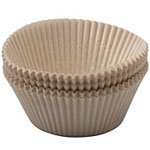 For a muffin tin, really any aluminum one (that’s NOT non-stick) will do. I’ve yet to find a stainless steel one that looks like it’s good enough quality to justify the price difference. Just make sure you use unbleached paper cupcake liners, or reusable silicone ones, so the aluminum won’t touch your food.
For a muffin tin, really any aluminum one (that’s NOT non-stick) will do. I’ve yet to find a stainless steel one that looks like it’s good enough quality to justify the price difference. Just make sure you use unbleached paper cupcake liners, or reusable silicone ones, so the aluminum won’t touch your food.
Miscellaneous
This pretty glass pie plate from my Pyrex set is my go-to for pies, quiches and such. Le Creuset also makes a gorgeous enamel-coated stoneware pie plate that I covet. Yummy.
Most round cake pans are made with aluminum, which you should avoid if possible. This is one made from stainless steel.
Springform pans are also usually made with aluminum. This is a silicone springform with a glass base.
A stainless steel roasting pan—as opposed to aluminum or nonstick—is a great piece to have in your kitchen. I love this Cuisinart one.
Whew!
There you have it! My ultimate guide to cookware, that only took me like 800 hours to compile. Hope it’s helpful. Any questions or suggestions of things I might add? Feel free to leave a comment below.
[disclosure: cmp.ly/4; cmp.ly/5]

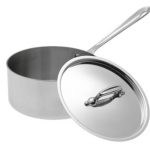

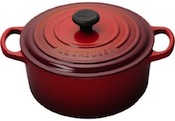
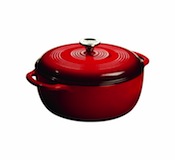
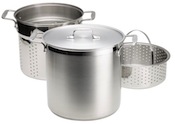
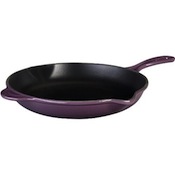

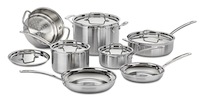
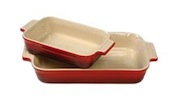
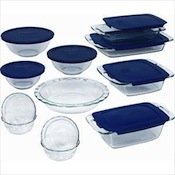


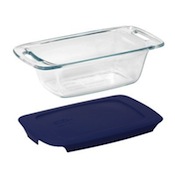
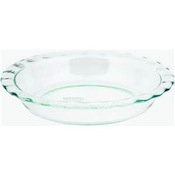
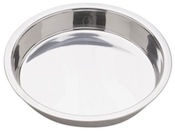
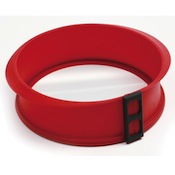

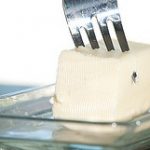


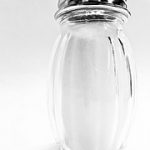
This is a great list…I might just give it to my husband to cover every holiday for the next 8 years or so! Except, I have one of those gorgeous Le Creuset stock pots and absolutely everything sticks to it. I can’t walk away from anything when using it.
Thanks! I have heard that the Le Creuset stock pots are really only meant to be used for liquids, like making soups, sauce, and stock. I think for anything you’d need to actually cook something in—like searing meat before adding the rest of the liquid—a regular stainless pot would be best.
Thank you for this list; it’s really helpful and informative. I am wondering if you can suggest non toxic dinnerware?
Thank you
Yes, I’ve used the Le Creuset too and have had problems with the food sticking, tried cooking on low heat and that helped somewhat but it took a long time. Even when cooking just liquids, the bottom (heavier food) gets stuck. The best and safest medium for cookware i think is natural clay, i switched all my cookware to pure-clay and it solved this sticking problem too. Food very rarely sticks to a seasoned clay pot. I looked for Pure clay cooking pots, made from tested clay & made in USA (important!)
I have been research on cookware as well. If I had the money, I would go with All-Clad. But what I have found is that I have gotten a really good bang for the buck with the Cuisinart Multiclad. I have the 12 and 8 qt stockpots, the 12″ skillet, the lasagna pan and several other pieces. They perform well on the stovetop as well as in the oven. Cleanup is easy and I will have these pans for a very long time.
I got the 6 quart Enameled Lodge Dutch Oven off my Wedding Registry. I LOVE IT! It is HUGE, so can handle my big soups, and I can totally neglect to clean it for a few days (I am a horrible housewife), and a short soak with water and it wipes completely clean. It has not been put away from my oven top since I opened the box!
I would agree with that, but I nearly ruined it once when I let some soup simmer without stirring for just a few minutes. I still use it, but just wanted everyone to know that it is far from non-stick! 🙂
At least the skillets and dutch ovens are! I wish they’d step up the quality on those stock pots. They seem to be the only product LC offers that ever gets bad reviews. Bummer!
The LC stockpots are okay. . . For stock. I make a lot of it, so the 12-qt is perfect for my kitchen, but I would probably throw it away if I’d bought it intending to make chili in it. Even though it’s the same enamel as the cast iron, the steel is just way too thin. Plus, the enamel chips really easily because it doesn’t bond well to the steel. Argh.
Also, their nonstick line is AWESOME. PFOA-free, still works on induction, and lifetime warranties. So cool! I love the 10-inch deep skillet (I think they call it the Universal Frypan) that I just got.
. . . I may or many not have a crushing cookware addiction 🙂
Being an APOE4 who eats a lot of fish (mostly salmon), still has a few mercury-laden fillings left and uses some cookware that is aluminum-based, I got just a little concerned about toxic metals.
Recently ordered a toxic metal blood test from LEF.org and just got back results. My blood had no detectable traces of aluminum, and my mercury level was low – below the recommended level for pregnant women.
I now how have my sanity back and those needless fears have disappeared. So instead of worrying about those killer pans, spend money on a test before giving the old cookware the heave-ho…just sayin.
If it’s anodized aluminum, which a lot of cookware from the last decade or so is, it won’t leach aluminum. But cheaper anodized aluminum is often coated in PFOA-type non-stick material. That’s my main concern. It’s highly toxic. And it’s not a heavy metal, so it won’t show up in a heavy metal lab test.
That’s pretty cool to hear that you had such low levels of mercury despite eating a lot of fish. And you have fillings! Great idea to actually get tested so you won’t have to worry so much.
That’s really great! However, it may be that your body is very good at flushing the toxins out. Not everyone has that ability. Personally, I’d just rather not risk it. Plus, there are all sorts of people that I cook for who I love, and I can’t know what their bodies are capable of.
Except for stainless steel, none of these choices work for glass-top stoves….all cast iron can damage these types of stoves as far as I know…
I use cast iron on mt glasstop with no problems. I think the concern is that they are heavy and could potentially break the glass, but I don’t slam my pots and pans around, so no issues. I didn’t know I wasn’t supposed to use cast iron on it when I purchased the range and I’m glad I didn’t.
We use cast iron and enameled cast iron on our glass top stove all the time with no issues. Just have to be a little more careful. 🙂
Wish we had gas but in my area, that’s just not feasible.
This was my FAVORITE Paragraph you wrote:
“Weell… that’s kind of a long story. But, I kind of get the feeling that most of the health-conscious people who read this blog are already fairly aware of these things. And if you’re not, you are free to Google your way into a nervous breakdown over discovering all the many fatal diseases you’re surely developing as a result of the cookware you’ve been using for the last decade or two. It’s like WebMD out there, you guys. One wrong click and you may as well start planning your own funeral”
Made me laugh! It reminds me of a term that we use to call people who self diagnose themselves due to WebMD or googling and then panic at all the “ailments” they diagnose themselves with….
“Cyber-chondriac”
Wow, nice post! Just wondering about the LC skillet… I thought they had a different coating, something other than the usual porcelain enamel… I’ve been afraid to find out what it is, do you know?
Nope! They did an actual nonstick coating on the cast iron for a little while (years ago), but the coating couldn’t take the heat of the pan and was kind of a disaster. It’s the same enamel – basically a clear coat that’s a little rougher than the white surface.
curious about your thought on the fairly new to market non-stick ceramic coated pans…
Me too, I have a couple of these I love and was surprised not to see mentioned.
The stainless steel roasting pan (Cuisinart) is expensive – IKEA has one for under $15!
Sweet! I’m sure it’s not quite the same quality… but hey if that works for ya, go for it!
Hi,
I saw your comment and thought I would offer you another option. I am with Demarle at Home. We are not only the CREATOR of the SILPAT (mentioned above) but we are the Gold standard in the professional culinary industry. Our products are Kosher certified for the oven, freezer, and microwave. They are also dishwasher safe. Our flexipans are made of pure food grade silicone and woven glass- no plastic, rubber or other toxic fillers, and no color additives. They are non-stick NATURALLY. Our Grande Mold is perfect to fit a nice size roast in, with some veggies, and you don’t even need to cover it. The mold can be used for many other things so it’s very versatile. It is also life-time guaranteed. Please check out my FB page, and there is the link to my website there. Or e-mail me and I can share more info with you directly. It’s a much more economic option, and you’ll likely fall in love with it just as all my customers have!
Thank you, Tarra
Awesome article. Thank you for taking the time to research and write this. It will definitely be of use to me when I buy new pots and pans 🙂
I was wondering if anyone ever looks at noon Teflon noon stick. I used to have hard anodized, which is not Teflon. Now i have a stainless set called eco cookware or something and it came with two (supposedly) environment friendl, not Teflon non stick that are light gray. And ideas? The rest of mine are stainless, cast iron and enameled cast iron. So i guess the aluminum includes lining something with foil, or using it on the grill too? Bummer!
Thank you for the great article! Any suggestions for donut pans?
Hi! I would love to talk with you about our donut mold! As I shared with a reader above, I am with Demarle at Home. We are not only the CREATOR of the SILPAT (mentioned above) but we are the Gold standard in the professional culinary industry. Our products are Kosher certified for the oven, freezer, and microwave. They are also dishwasher safe. Our flexipans are made of pure food grade silicone and woven glass- no plastic, rubber or other toxic fillers, and no color additives. They are non-stick NATURALLY. Our donut mold would be perfect for your needs, I guarantee it. As does our company, it is also life-time guaranteed against defect. Please check out my website, and there is the link to my FB at the bottom of my intro. Or e-mail me and I can share more info with you directly. It’s a much safer option than what’s in stores, and you’ll likely fall in love with it just as all my customers have, and want to further your collection beyond the donut mold!
Thank you, Tarra
Do you have a website that shows your products? Thanks
Any comments on using stoneware? That’s what I use for almost all my baking…
I prefer the enamel-coated kind, like the LC items I mentioned, but I’m interested in getting a stoneware pizza thing. Is that worth an honorable mention here? Any other specific stoneware baking stuff you think needs to be added?
My baking pans, cookie sheet, loaf pan, pie pan, Dutch oven, etc. are all Stoneware (Pampered Chef).
Please e-mail me! We need to talk! I have a product that I am confident you will love! I just replaced ALL of my Pampered Chef stoneware with it in February. I will never go back, it has really changed not only how we cook, but our kitchen set up as well! Flexipans take up far less space, and weigh next to nothing compared to stoneware! TarraParks@gmail.com
I swear I commented this morning but can’t find it…. I used to have hard anodized, a full set from Costco. Then we got an Eco something set from sams club that I don’t see on they site. It’s all stainless with two skillets being a non stick that they claim is not Teflon and safe, I will look for the box to see what else it says.. Is a very light gray surface.
Great information. Thanks for the work in gathering it! Glad to see you included glass, so clean and practicle.
Also consider eating more alive raw foods with less cooking worries, better nutrition, and more savings in fewer pots and storage space.
I wouldn’t use the Lodge regular cast iron. They are all pre-seasoned with soybean oil. I have seen another company that sells unseasoned versions. Lodge used to sell unseasoned versions but they no longer do.
Well, for one thing, you can easily strip the seasoning and re-do it with whatever fat you’d want to season it with.
But, I think it’s important to understand the science behind seasoning—that soybean oil isn’t soybean oil anymore once it’s been polymerized. The pan will also continue to form more and more layers of polymerized fat the more you continue to cook with it and re-season it over time.
I was surprised not to see any stoneware listed here. I use pampered chef stoneware in lieu of metal baking pans as often as I can (I need to get some more sizes). Is there a reason to avoid these?
What about the ceramic pots from Dr Mercola or Ceramicore? I believe those should top your list.
High quality ceramic is fine, sure, but it’s also very expensive. A ceramic pot could also potentially break if dropped or mishandled, whereas you’d never be able to even dent an enamel-coated cast iron piece like a Le Creuset. For almost the same price, I would never pick ceramic over enamel for this reason.
Thanks for compiling this. I need to update my cook/bakeware, but will have to go about it slowly. It makes me mad that some companies can be so misleading. I recently purchased a non-stick pan from a company called ‘Ecolution’ that boasted no PFOAs, but when I got home and did further research, I found that the pan is made of aluminum! I’m amazed that they pride themselves on being ‘health-conscious’ and then make their products out of harmful metals. I’m glad to have this list now at least. 🙂
Thank you for this helpful article! I am slowly replacing my hard anodized cookware with stainless steel and cast iron…one piece at a time due to the cost. I was kind of surprised that you didn’t mention stoneware as a good option for baking…it is made out of clay and works similar to the cast iron where it becomes nonstick the more you use it. I think it is a nice alternative to glass and aluminum…your thoughts?
Not so much Holly. I used to sell PC. I grew to really not like it over the years, and I had an extensive collection. It is porous, will absorb foods, bacteria, and allergens, and is a pain in the rear to clean and store (flat ones aren’t so bad, I mean the casserole or walled ones). I got rid of all of my stoneware just this February, when I was introduced to Flexipans and Silpat- products from Demarle at Home. They changed my kitchen/cooking life, and are changing other’s too, one chef at a time. I know you sell it, so I am writing this with the most respectful intent. You don’t know until you know, right?
Very informative article, thank you.
Do you have any info on the safety of silicone bakeware?
Thank you for writing this! I have been working on tackling cookware and it can get overwhelming!
I am trying to read your disclosure at the bottom of the post and neither link works.
Thanks for letting me know—the code was all messed up, but it’s fixed now. I usually link to the specific cmp.ly pages, but, I do have my own disclosure/disclaimer statement for the site here.
I recently inherited some muffin tins from my grandmother and used that opportunity to get rid of my non-stick muffin tins. I’ve been using them without liners (to avoid the waste) and assuming that they’d be ok. Is there an easy way to know if they’re aluminum, or should I assume that’s what they would be?
Not sure if there’s a way to tell for sure, but I think it’s probably pretty safe to assume they’re aluminum. Very common material for that generation. If it were me, I’d use them with liners, but if you don’t make muffins/cupcakes all that often, it’s probably fine to skip it. That’s pretty awesome that you got those tins though! Plain aluminum ones like that (without nonstick coating) are a lot harder to find now.
hi
great list and info- i totally agree with your choices.. i will pass this pn- except I’m wondering why you dot mention pampered chef for baking ? THey are great products and i think perhaps worth adding to your list.
I’m sure they’re safe, but, judging by reviews on Amazon, they are not that durable and break fairly easily. Pampered Chef does seem to have a good policy for replacing them, though.
I’ve had mine for almost 15 years of solid use (almost all my baking needs are met by the stoneware) without any problems whatsoever.
What about Corning (Pyrex) Vision cookware? Made of a non-porous glass-ceramic material which won’t absorb food odors or flavors or react with acid-based foods.
I’ve been using these for years. Some say they can explode but the only problem I have had is nicking the lids from dropping them. I know older ones had Teflon non-stick interiors.
Thank you so much for making it easier to go shop for the healthiest kitchen for my little tribe. In my case, I moved to the States from France and only brought my extra light non stick Flexipan and Silpat bake ware in my suitcase. Since then, these are the only ones I keep purchasing because it doesn’t wake up my sleeping baby, easy to clean and store. My kids cook with me and I don’t hold my breath in the eventuality they could break something and endanger themselves. If you love your Silpat, you should check out their cookware and bake ware from the same maker.
I know this is not cookware but do you have any suggestion for tea kettles?
I would recommend a cast iron tea kettle!
I would love an answer to this question as well. In fact, it brought me to this website. Where do you find a non toxic TEA KETTLE?? Without plastic, without lead (so far the only kettles without plastic, metals, silicones, are the glass ones..yet I can’t find a glass kettle without lead. Very frustrating. Just try searching for a non toxic tea kettle. I don’t believe one exists.
Interesting article and great advice about buying the pots that you need. One thing that you didn’t mention was the need to get hands on with your pots before buying them. Try that pot that’s going to cook potatoes and be sure that it’s comfortable when trying to drain the water (if you can’t easily hold it at 90 degrees when it’s empty whatever will you do when it’s full).
I’m not going to give up my STAUB enameled pot but my Kitchen Aid was 1/10 the price on sale at Canadian Tire and their ceramic ware is really nice too (and similarly priced)
Haha! I LOVE this post!! How accurately you portray us real foodies and the nerve-splintering processes we go through every day!
How about graniteware? I bought it after reading ur post? Is it nontoxic?
Shoot, I probably should go stick that in here. Graniteware is a good choice if you really can’t afford any of the other options, but, it unfortunately is not very durable. Once the coating chips or cracks, I would throw the pot away, cause you don’t want what’s underneath in contact with your food.
I’m surprised you didn’t mention Ceramcor Xtrema cookwar at all, any reason for that?
I wouldn’t buy it, myself. It’s safe, sure, but very expensive and not as durable as these other choices. A ceramic pot could potentially break if dropped or mishandled, whereas you’d never be able to even dent an enamel-coated cast iron piece like a Le Creuset. For almost the same price, I would never pick ceramic over enamel for this reason.
This is super-helpful; thanks so much! I’m pinning it for future reference as I gradually reform my collection…
Very informative article. I’ve been researching and trying different cookware. I was able to find some of the old Visionware glass cookware. It works well for things with a higher liquid content but is not good for frying. Doesn’t distribute the heat evenly enough. For frying I use cast iron, stainless for stock and glass for baking. My chemist husband says that silicone is pretty reactive so I haven’t used any of the silicone bake ware or silpats, only sheets in my dehydrator which is low temp. Does anyone have any info on the safety of the use of silicone at higher temps?
http://www.drweil.com/drw/u/id/QAA400274
silicone safety
What about the new ceramic nonstick skillets? They’re touted as safe but I don’t know. And for baking, I use Pampered Chef’s baking stones. Yes or no?
i use aluminium pots for my wood oven. do you suggest anything better? stainless steel gets darken in those high temperatures
What about glass pots and pans, are those safe?
thank you for putting this together, it made a lot more sense than me just perusing amazon aimlessly, especially since you specified what works best for which piece. i’ve been needing to replace certain kitchen items, and this really is wonderful!
I notice that you haven’t included stoneware in this list. I have Pampered Chef Stone for all my baking ware – muffins, cookies, breads, cakes, etc. I have multiple sizes and shapes. I love them!
I used to use all stainless steel (after I realized that teflon was horrible) but I switched to cast iron for my skillets. I still use stainless steel for my pots, allthough someone gave me an enamel pot, and I love it. I’ll probably switch to enamel pots before long.
Cast iron, Stoneware, and Enamel are SO easy to use!! I’m so glad I made the switch.
This is very helpful information. I have done research and can’t seem to find a definitive answer on the safety of Calphalon nonstick pans. The company says that it is their own compound which is safe, unlike Teflon. What are your thoughts on Calphalon.
Have you received a response about this? I, too, have Calphalon pans and would like to know about their safety. Thanks!
This is the list I was looking for. It is so confusing these days to find a durable yet healthier set of pots/pans. I didn’t see you mention any of the new “green pans” they advertise these days. Thoughts?
Also thanks so much for the tips on cast iron and what “not to cook” on them. I am now wondering if my seasoning was done correctly- going back to check in a minute. Awesome- bookmarked 🙂
What about titanium cookware?
The article is essential. But I am surprised no mention to glass cookware. Also, what about the raw pots coated with molasses (the refined substance from sugarcane and grapes). Any idea how good/bad they are?
Hi, Im from asian background and i always use, in place of dutch oven, a clay cooking pot to cook stew or soups or braising. I would like to think it s the same as dutch oven (only much cheaper) because it can be used on stovetop and oven. It looked something like this http://www.asianfoodgrocer.com/product/black-short-clay-cooking-pot
My question is, do you know whether it is safe to use? Or should i worry about anything leeching from the clay? Thank you
Do you have any information on utensils? White the pans are a big deal, I feel like the utensils would be important too.
BTW – just read your book and love it!
I’m sure there are good reasons to avoid aluminum, but I want to point out that the Alzheimer’s connection was discounted by neuroscientists by the time I was in college over 15 years ago. In autopsies early researchers found aluminum in the brains of Alzheimer’s sufferers, but later on it turned out to be coincidental (aka correlation does not imply causation). http://www.alz.org/alzheimers_disease_myths_about_alzheimers.asp
Other than that, great article! We adore our cast iron pans.
What are your thoughts on ceramic? My pots and pans are ceramic plated.
Thanks for sharing such great information about nonstick cookware. I did a quite research in nonstick cookware and read some useful information in the Best Nonstick Cookware as well.
Have you ever seen these? http://www.usapans.com/
Thoughts? I’d LOVE to know because I’ve debated putting them on a wish list…
I was also wondering about the USApans, with regards to the proprietary silicone coating…wa\hat are your thoughts on that? I’d like to get a good donut pan…so, I can make homemade donuts.
What about those ones they’ve been advertising on TV….the greenorganics, or something like that? I recently got a skillet like that …….I have to admit I love it, but not if it’s impairing our health…..thanks for the reply….
Do you have any recommendations on slow cookers? It looks like there is no lead free option
I use All Clad stainless steel for most of my cooking except for eggs and fish. Eggs and fish tend to stick when I cook them in stainless so what’s the best safe and healthy alternative to “non stick Teflon pans”?
Love the information! I recently bought some wear ever and it is not the stuff my mom used. Booooo….I’ve sent one pot back, the rest are already doing some kind of pitting and the grommets are corroding. Ghaaaaa! Thanks for the advise and experience!
Great article. I’ve been thinking a lot about the non stick issue now that I have a baby. Do you have any recommendations for nonstick type grills that are similar to a foreman grill? Do they make any coated with enamel? My husband and I have used a foreman grill a few times a week for last few years for quick meals. Although we really like the convenience and time saving, we no longer are using. Working full time, it was a huge timesaver. I’d like something we could use to cook our daughters food on too.
A great list! I’d like to add to it amazing cookware from a Swiss company called Zepter. It’s made of the highest quality stainless steel which allows for food preparation without the use of oil and/or water. An absolute must have! Check it out:
http://zepterinternational.com
Thank you for the hard work in putting this post together. I still have a few good ol stainless steel pots that I use. I also use ceramic now. I often go over to friends and family houses who use this non-stick. And even though I tell them the issues with it (most of it has tons of scratches leeching bad stuff into food) they think I am crazy or just shake their head. Why are people so foolish in the age of Google and smartphones lol? Thanks for a great list, bookmarked for future reference when I will be buying cookware 🙂
Toney.
This is such an incredibly helpful list. Thank you so much for the time you took to write it!!
I’m glad you found it helpful! Thanks, Jessica!
Here’s a couple posts on silicone:
http://www.drweil.com/drw/u/id/QAA400274
http://green.yourway.net/is-silicone-bakeware-really-safe/
The second one kinda copies the first.
I just got rid of all my pans and switched to stainless steel for cooking and glass for some baking.
I LOVE THE EXPLANATIONS YOU GAVE ON THE DIFFERENT TYPES OF COOKWARE ABOVE. I DO HAVE A QUESTION THOUGH. WHAT ABOUT CAPHALON POTS & PANS? IS THERE ANYTHING I SHOULD KNOW? ARE THEY ALSO A GOOD ALTERNATIVE? THANKS FOR LISTENING.
What do you cook rice in? I love my non stick Aroma rice cooker!
I just use my little red Le Creuset pot! I melt coconut oil in the bottom, then add the rice and water and it works just fine for me! One less appliance to take up space in the cupboards. 🙂
This was such a helpful list – Thank you! I used it when putting together my wedding registry. Do you have an opinion on teakettles that are non-toxic? Thank you again!
What do you think about the new enamel non-stick pans like orgreenic?
I’m wondering if anyone has checked into the enamel cookware that Costco offers. I’d assume it’s quality, but haven’t done the research yet.
I’ve been looking for a list like this for years! Thank you, you did a fantastic job!
Hi!
In case you hadn’t heard, Le Creuset’s stoneware is produced in China, ONLY their cast iron products are still made in France. China is Known for their lack of concern when it comes to producing food safe product glazes/jewelry finishes/toys etc. so I’d NEVER buy anything made there that I would use to cook with.
Looking for opinions regarding any health issues using an induction cooktop by Wolf with stainless steel All Clad or Le Creuset cookware. Considering a combo 30″ cooktop with 2 burners/gas and 2/induction burners for our kitchen upgrade. Vent a hood with magic lung centrifical/fan 300cfm. Can’t find enough online info related to efms and safety in cooking!! HELP needed
Do you have a guide to choosing a good knife set?
I never respond to these blogs, but I felt I had to comment on the advice about how to use cast iron – because, respectfully, I do not agree with the recommendation to refrain from using it for “wet” applications. I have been cooking for 30-plus years and I especially treasure my cast iron dutch oven for soups, stews, chilies and spaghetti sauces: Any dietary iron that might be derived from the cookware is a plus for vegetarians, the natural non-stick surface is a joy to cook with and the possibility of scorching can be mitigated by using a heat pad under the pot for long-simmering dishes. What’s not to love?
The stainless cookware is good but most all have aluminum rivets in the handle that is not good it leaches in to the food to. Why do they this it’s not that much more to use stainless rivets.
you dont mention baking stones for baking. is there a reason, i always use baking stones and even stone baking dishes for casseroles
is there a reason why you dont mention these or should i be using something different?
We recently had a Saladmaster home salesperson cook our family dinner and convince us that we needed the surgical grade titanium stainless steel to cook with. We did not buy but are conviced we need to replace our pots and pans. I found your website and love this guide! I did however find on amazon some Mazam “surgical stainless steel” cookware that looks pretty identical to saladmasters cookware. I’m wondering what your thoughts and knowledge are about these waterless cooking pots and pans? I was hoping they would be on your list! I am now trying to choose between your suggestion of Cuisinarts cookware set and these:
http://www.amazon.com/Maxam-KT17-9-Element-Surgical-Stainless-Steel-Waterless/dp/B00077BHPS/ref=sr_1_1?ie=UTF8&qid=1385445585&sr=8-1&keywords=saladmaster+cookware
Hi Lindsey,
I’ve been using Saladmaster cookware and bakeware since the 1980’s. I’ve recently replaced and added some new pieces. I can’t speak to the technical point of view. They hold up very well and cook beautifully. I would be interested in other opinions as well. Yes, it’s expensive, but then so is Le Creuset!
I’ve been eating food cooked in aluminum and teflon coated pans for over 50 of my 78 years on earth. Should I expect to die soon because of this?
Lol. Yep! 😉
Would love your thoughts on the Staub Dutch oven and also on baking stones.
Very informative article, but I only see items that are available from commercial stores, ie., Macy’s, Younker’s, Williams Sonoma. What about products from direct sales companies like The Pampered Chef?
Hi Emily,
Love your article. I started cooking at the age of 10 in China and had always used a well seasoned wok. I started using a non-stick frying pan when I went to the US – loved the non-stick aspect, but hated the heat loss when doing stir frying, and didn’t know anything about the harmful chemicals! Now, I’d love to go back to the cast iron wok, but it’s heavy and hard on my arthritis. Would you care to comment on the cookware with ceramic coating, like NeoFlam? Is it safe as they claim? Many thanks. KD
I love the idea of the pressure cooker. Your not worried about that stainless leaching (like the other lower quality stainless you mentioned above)and your using vinegar? Would love your thoughts. Thanks!
have you looked into any of the Pampered Chef pans? they have several different lines including one that’s completely stainless steel and they have another one that’s a line that’s only stoneware
I have had a set of townecraft stainless steel cookware for 12 years. I love it!! Still looks the same and has a lifetime warranty on it. I even have a wonderful electric skillet that is just awesome and can be washed in the dishwasher!! My mom has had the same set for over 30 years and still looks like mine! She has had to replace a couple handles, and that is all! It is very pricey, but worth it!
I have had a Le’Cruset dutch oven too! I loved it (till my hubby scorched it trying to pop popcorn).
What about fun bake ware – like heart pans, mini muffin pans, bundt cake pans, etc.?
Also, how do you keep things from sticking on Stainless? We have tried everything!
Not sticking on stainless means getting it hot enough, letting the meat stick for a moment, and then it will release nicely. http://www.youtube.com/watch?v=CB-SCA1reqE
I like to use carbon steel pans. You get many of the benefits of cast iron, but at a fraction of the weight. They season well and are indestructible. They’re often used in professional kitchens.
Hi this is very very useful for me. I just love it.great and beautiful.
Hello. I am one of those crazy people who are trying to catch up on the healthy lifestyle as I lived in denial for a long time. I am wondering if Wolfgang Puck is a brand that seems alright. There is a 14 piece set at BJ’s wholesale for $100. I was hoping to go get it but dont want to waste money as we are on a tight budget. Thank you.
I have always thought that buying healthy cookware is incredibly important but, unfortunately, plenty of the people I know have not shared this belief. I think that you should always know what you are putting into your body – and this includes whatever could have come off the cookware that you are using to prepare meals. This has been a very clear guide and I thank you for sharing.
Thank you for this awesome review!!
Thank you for your info. I have recently receive a set of Calphalon. Do you know about their stainless steel qaulity?
A poster on Perfect Health Diet official Facebook group states that enameled cookware loses glaze into the food, same with crock pots. He says titanium is the only safe cookware, but gives a good endorsement of All Clad.
My Cuisinart and Calphalon are all magnetic outside and inside. Not strongly magnetic, but the magnet sticks.
lana
I thought all Lodge cookware was made in China?
I am currently in the process of switching all plastic over to glass but as this is a safety article I thought you should be aware that Pyrex dishes (or any glass cookware) has a risk of exploding or shattering.
http://www.snopes.com/food/warnings/pyrex.asp
Interesting article. Stay smart, stay safe folks 🙂
Can you tell me your thoughts on if this is safe? http://www.amazon.com/gp/aw/d/B001B2NA4E Supposedly it is very similar to All-Clad, but I’m not convinced with the aluminum in it. I’d appreciate your thoughts? Thanks! 🙂
Thanks for the info! Could you please suggest a frying pan or skillet that would be safe, non stick and good for eggs. My eggs always seem to stick!
Also, do you have a suggestion for a stove top wok and grill pan?
Thanks!
I have used Aristo-Craft stainless steel cookware for years! A magnet does not stick anywhere on the covers. However, a magnet sticks to the INSIDE as well as the outside of the pans, but does not stick to the outside bottom at all. I believe your article stated you had never heard of magnetic properties to both inside and out on pans. Have you heard of this brand, which I think is no longer manufactured. Comments, please! I hope they are safe after all these years!!
I use quite a bit of silicone for baking (and un-baking via fridge or freezer). I had no idea that there was a silicone spring form pan. Awesome!
This post is very educational, and I’m glad you were so thorough and gave examples of what good sizes & brands are available.
Thank you!
Thank you, Beth! I’m so glad you found it helpful. 🙂
I’m very concerned about excessive metal in the body period.Eventhogh I am a 27 year old female, i have high iron leavels in my blood, possibly from drinking wellwater for two years, and have sufered numerous health problems because of it. although I haven’t been tested I suspect I also have other metal toxicities like copper, aluminum, mercury, and lead. I’ve read in a few other places that stainless steel leeches aluminum, so I hope I can find something that works. Think you, for this list of cookware options, but i think i will try to use glass for baking and my teapot and a bambo steamer for my veggies, to avoid metal as much as posible.
I’m not sure if you will see this on an old post, but I would not recommend the Cuisinart multiclad. The actual Cuisinart website does not say it is 18/10 stainless steel, whereas Amazon does. I emailed the company, and they said they are 18/10 stainless steel but they do not print it on the bottom. If they are not 18/10 then they are stainless steel. I replied for further clarification, but multiple reviewers on Amazon said the same thing. If something made in China cannot confirm they type of metal, I will not buy it! Tramontina has a gourmet tri-ply clad line that is actually 18/10 ss. That’s what I would recommend as a cheaper alternative to All-Clad. This is not the same cheap tramontina that just has a tri-ply base. I am deciding between All-Clad and the gourmet Tramontina, and waiting until Black friday to see if I can get a good deal 🙂
You’re recommending Pyrex glass but since World Market bought Corning they changed out the Borosilicate Glass and now use Soda Lime which is much less expensive. As a result there have been many complaints about these dishes exploding into millions of pieces..while it may not be toxic, idk, it certainly is not safe
Hello,
I have a Hawkins Future Pressure cooker. It is hard-anodized aluminum with a satilon finish, as stated on the product box, manufactured in 1985. It also states it has a non-stick surface. I am wondering if this product could have toxic leakage or PFOA issues. Would you be so kind to share your opinion, if it is safe to cook with? Would you use it for your own family? I came across your article, and am basing most of my new kitchen purchases from your recommendations, your opinion and research has been very helpful to our families health. Thank you in advance for your help.
Do you have any comments/thoughts about the safety of stainless steel lunch food carriers? Glass isn’t safe for little kids to take to school so I see a lot of them with what must be expensive stainless steel sets for their cut-up veggies, etc. What a conundrum!
I can’t make a decision the calaphon tri ply or the Cuisinart multi clad you recommend here. Which is less toxic. In desperate need to buy asap. Please help
I’m having a hard time figuring out if granite ware better browning pans are safe to use! Have you researched those?
Hi Emily
would you have a minute to review this product and tell me what you think about it ?
It’s available at my Costco at great price
http://www.greenpan.ca/en/miami-collection-6905.htm
thanks
Annie